14
Hibernia School Sign, about 1950
1950
Hibernia
 Credits:
Credits:
Queens County Museum Collection
15
Hibernia consisted of two school districts: Hibernia and Upper Hibernia. In the late 1890s considerable controversy erupted over the location of a new school building in Hibernia. Some favoured the site of the building to be replaced, others reasonably thought the center of the district which the school served made the most sense. The sign featured here was placed on the front of the new building.
16
Hibernia School, 1952
1952
Hibernia
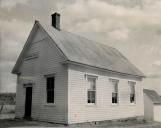 Credits:
Credits:
Base Gagetown Community History Association
17
Hibernia resident Lloyd Nickerson recalls the Hibernia School:
"Most country schools of the turn of the century were built of a size estimated to hold the required five grades and later eight grades in one room. Construction, of course, was wood throughout, built on a rock or masonry foundation having a peaked roof leaving an attic space between the roof and ceiling of the schoolroom. The Hibernia School had one entrance into the boy's cloakroom with a side door into the girl's cloakroom."
From Along Hibernia Roads, Compiled by Connie Mullin Denby and Carol McCorkle Lawson, 2003.
18
Summer Hill School, 1952
1952
Summer Hill
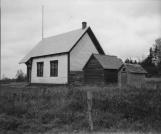 Credits:
Credits:
Base Gagetown Community History Association
19
The school at Summer Hill seems to have followed a prescribed design as it is almost identical to the school at North Clones. The list of teachers for Summer Hill includes the sons and daughters of the local residents: Gardiners, Nickersons, Corbetts, Armstrongs, Kerrs and Dunns to name a few.
20
Dunn's Corner School, 1952
1952
Dunn's Corner
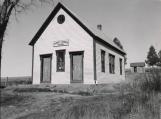 Credits:
Credits:
Base Gagetown Community History Association
21
The Dunn's Corner School followed another architectural design that featured two entrances on the front, one for boys and one for girls. Teachers were contracted for a term or the entire year, depending upon the district and the wishes of the directors. Most were local men and women while others arrived from away, married and settled into the rythym of rural life.
22
Lawfield School, 1952
1952
Lawfield
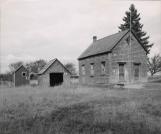 Credits:
Credits:
Base Gagetown Community History Association
23
The Lawfield School showing the wood shed and privy. School days began at 9:00 am and finished at 4:00 pm with a break for recess between 10:00-10:15 am and then another break from 2:45-3:00 pm.
24
Coote Hill School, 1952
1952
Coote Hill
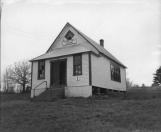 Credits:
Credits:
Base Gagetown Community History Association
25
A school was established in Coote Hill in 1827, making it one of the earliest in the area. Subjects included reading, writing and arithmetic. The school shown here was built in 1872 and served a district three miles long with an average enrolment of eighteen students. The old wood stove in the center of the building was used for warming lunches on cold days.
26
School Trustees Seal, about 1950. Petersville Consolidated School District
1950
Petersville

27
This School Trustees Seal is from the Petersville Consolidated School District. Trustees were responsible for contracting teachers and supervising their instruction. They were also charged with raising funds for books and making repairs to the structures.






